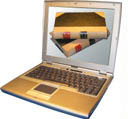Friday, 29 February 2008
Some colleagues of mine (Paul H. Jensen, Alfons Palangkaraya and Elizabeth Webster), from the Melbourne Institute of Applied Economic and Social Research, have published a new Working Paper that would be of interest to people who, like me, are fascinated by international dynamics in patenting. The paper is called ‘Application pendency times and outcomes across four patent offices‘.
OK, so it’s not the most exciting title in the world. But here’s the thing. They’ve got matched patents applied for in Europe, the US, Japan and Australia, and worked out differences – in outcomes, and how long it takes to get a patent – for the same invention. They’re measuring differences in approach between the different patent offices! How many people do you know who can do that? Here’s an extract from the introduction:
Our study is based on a set of 9,618 patent applications from the same patent family that were submitted to the APO, EPO, JPO and USPTO during the period 1990-1995. The matching criterion is that the applications must specify the same unique priority number. Thus, our sample covers applications for the same unique inventions (i.e. the same subject matter) that were sent to all four patent offices.2 The chosen time period allows enough time so that all applications should have either been examined or withdrawn by the end of 2004. Using this sample, we examine i) how much disharmony there is across international patent offices in terms of examination outcomes and ii) how much variation there is in the time taken to examine an application.
There are a number of striking results from our comparison. First, we find that there is substantial variation across the offices in terms of examination outcomes. For example, Japan only grants 40 per cent of those applications that are granted by both the APO and the USPTO (although a large proportion of applications at the JPO are withdrawn). Compared to the other offices, the APO is the closest to the USPTO in terms of the relative proportion of patents granted. Secondly, we also find substantial variation in patent pendency periods across the patent offices. The time taken to examine an application (i.e. after the request to examine has been made by the applicant) is on average shortest at the APO (approximately 14 months) and longest at the EPO (approximately 42 months). However, the overall period in which the status of the application is pending, which also depends on the request lag, varies from 24 months at the USPTO to 88 months at the JPO.’
As Larry Solum would say: highly recommended.
2 Responses to “New and interesting Patent Stats comparing USPTO, JPO, EPO and Australian Patent Office”
Leave a Reply
Do not post material that is defamatory or obscene, that infringes any third party's copyrights, trademarks or other proprietary rights, or that violates any other right of any other person.
We reserve the right to remove or edit any comment for any reason.
Note: Posting more than two links in a comment may cause it not to appear because it will be submitted for moderation. Also, links in comments will not be counted by Google, so spamming is pointless.

February 29th, 2008 at 3:21 pm
It’s the quality of the review (by patent clerks who can figure out prior art) that is important, and fee-payers might not want prior art discovered.
It doesn’t surprise me that US and Oz patents offices grant more applications than others.
Remember Australian Innovation Patent (Application 2001100012 24-May-2001, granted Aug 2001 to JM Keogh of Melbourne) that was for a “Circular Transportation Facilitation Device”.
Here is the record, and here is the application, complete with pictures.
Yep, our glorious patents investigations couldn’t recognize the wheel as prior art, only millenia out-of-date!
February 29th, 2008 at 4:15 pm
Oh now be fair Dave. The patent for the ‘circular transportation facilitation device’ was an innovation patent. That means it was not examined at the time the patent was applied for. Innovation patents are only examined if you want to enforce them – and you can’t enforce them unless you have them examined. So the ‘wheel patent’ was never enforceable. It was a joke!